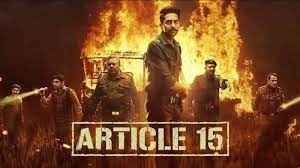The movie that exposes India’s ingrained caste prejudices is described in Article 15
Through the lens of film, some of the most significant societal concerns have constantly been explored and brought to light. “Article 15” is one such film that offers a dramatic illustration of its potency. When it was released in 2019, Anubhav Sinha’s film, which tackles the harsh truths of Indian culture by taking inspiration from a variety of real-life occurrences, earned positive reviews. While “Article 15” isn’t based on a single particular occurrence, it does draw inspiration from a number of instances, including the alleged gang rape in Badaun in 2014 and the flogging episode in Una in 2016, to tell a gripping story that emphasizes the endemic caste-based prejudice in India.
It is essential to provide a brief synopsis of “Article 15” before discussing the real-life sources for the film. The movie, which features Ayushmann Khurrana, follows the life of Ayan Ranjan, an idealistic Indian Police Service officer posted in a small Uttar Pradesh hamlet. He is confronted with the depressing reality of caste-based prejudice when he takes over a police station in Lalgaon, a city that is severely split along caste lines.
The story of the film progresses as Ayan gets embroiled in a case concerning the disappearance of two young Dalit (lower-caste) girls. The local administration is reluctant to carry out a full probe because of caste stereotypes. Ayan uncovers a network of injustice, cruelty, and corruption that the dominating upper-caste elite has been doing against the oppressed Dalit minority when he looks more into the case. Ayan’s relentless pursuit of justice serves as the narrative’s driving force, and the film does a good job of highlighting the structural injustice that exists in Indian culture.
While “Article 15” doesn’t explicitly imitate any specific event, it draws extensively on a variety of real-life incidents that serve as grim reminders of caste-based discrimination’s pervasiveness in India.
One of the most well-known occurrences that influenced the movie’s narrative was the gang rape charges in Badaun in 2014. In this horrible event, two adolescent Dalit girls were found hanging from a tree in Badaun, Uttar Pradesh. The case was first ruled out as a suicide, but further police investigations uncovered evidence of a brutal gang rape and murder.
The movie “Article 15” portrays the prejudice, negligence, and apathy of the local authorities. Comparable to the efforts made by activists and investigative journalists to seek justice for the Badaun case victims is Ayan’s dedication to learning the truth and upholding the law.
The Gujarat Una flogging episode in 2016 also had a big effect on the movie’s plot. Four Dalit men were beaten and publically humiliated by self-proclaimed “cow protectors” for skinning a dead cow. The act provoked considerable indignation and protests against caste-based violence.
The way in which violence against Dalits is portrayed in “Article 15” and the feeling of impunity the offenders feel is comparable to what took place in Una. In a nod to the public indignation and cries for justice that followed the Una tragedy, the movie poses the question of whether individuals in positions of power were also implicated.
In addition to emphasizing these specific occurrences, “Article 15” also raises awareness of the pervasive caste-based prejudice that continues to exist in some parts of India. It shows how the caste system still affects many facets of society, such as access to justice, career prospects, and educational chances.
The video shows the glaring disparities in living standards, access to needs, and the prevalent attitude of superiority among upper-caste people. Through its characters’ interactions, “Article 15” presents a microcosm of Indian society where the marginalized and disadvantaged struggle to break free from discrimination.
More than merely a movie, “Article 15” is a powerful mirror held up to Indian culture, revealing its most disturbing and repulsive facts. The film does more than just chronicle numerous true stories, such the charges of gang rape in Badaun in 2014 and Una’s flogging in 2016. These sources of inspiration are incorporated into a compelling narrative that explores the depths of caste-based discrimination, corruption, and injustice that continue to plague the nation.
Through the persona of Ayan Ranjan, “Article 15” depicts the prospect of change for those working within the system to defend justice and equality. The film urges society to confront the deeply rooted biases and preconceptions that underpin caste-based discrimination by acting as a wake-up call.
A powerful cinematic masterpiece, “Article 15” urges spectators to consider and act for a society that is more fair and equal. It not only amuses, but also instructs and amuses while doing so. Although the movie is a work of fiction, it serves as a reminder that the brutal realities it portrays are all too real and need our attention and action.







